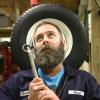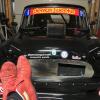Using Caliper Bolts To Measure Castor Angle

Best Answer Spider , 08 March 2024 - 05:17 PM
Yes, they are parallel and I have made such a 'device'. It's a simple angle bracket on to which I have a magnetic protractor to put on it and directly measure the angle off. I found this tedious and made another similar 'adaptor' that goes over the upper and lower ball joint nuts. Being spaced further apart, it's a wee bit more accurate too.
With these gadgets, there's no need to check it 200 either side, though, that's a good idea to check after setting it in the straight ahead position.
The 200 (or you can use any angle) steering angle each way is used when all you have is Camber Angle Measuring gear. Using a formula you can then work out what the Castor Angle is.
The formula here is Caster0 = (180 / 3.1415) x (( Camber 10 -Camber 20) / (Turn-angle 10 - Turn-angle20))
Go to the full post
#16

Posted 13 March 2024 - 01:28 PM
#17

Posted 13 March 2024 - 01:37 PM
3.5"
#18

Posted 13 March 2024 - 01:57 PM
Perfect, thought it had to be, thanks3.5"
#19

Posted 13 March 2024 - 05:26 PM
Does anyone have you hand what is the official caliper bolt spacing? Making our own guage..
From the drawing it's 3.500 to 3.505".
#20

Posted 14 March 2024 - 07:35 PM
The gizmo...
OMG this is going to be a game changer. I have wasted *so* many hours measuring caster with the 20deg. turn method.
Thank you! (model downloaded and printing now)
#21

Posted 15 March 2024 - 11:59 AM
That's really well thought out. I was wondering if it'd be possible to do it with the calipers in situ. You had me toying with centre drilling caliper bolts or making up little L brackets.
Looking at your photos makes me wonder if you couldn't develop it further by using the damper pin as your datum.
#22

Posted 15 March 2024 - 05:10 PM
That's really well thought out. I was wondering if it'd be possible to do it with the calipers in situ. You had me toying with centre drilling caliper bolts or making up little L brackets.
Looking at your photos makes me wonder if you couldn't develop it further by using the damper pin as your datum.
If you are looking for that nth degree accuracy, you wouldn't use the Caliper Threads. They are on paper' parallel with the Ball Joint Centres, but they have a 0.010" tolerance - bearing in mind that's on each hole, so the total accumulated error here could add up to 0.040" or 1 mm, though, on the hubs I've measured, I found this to be 0.006" or better.
Also, even if the shock pin was of an acceptable tolerance, the attitude or angle of the car to the ground isn't taken in to account when measuring castor from that pin. True Castor Angle is measured to the ground.
#23

Posted 15 March 2024 - 06:02 PM
That's really well thought out. I was wondering if it'd be possible to do it with the calipers in situ. You had me toying with centre drilling caliper bolts or making up little L brackets.
Looking at your photos makes me wonder if you couldn't develop it further by using the damper pin as your datum.
If you are looking for that nth degree accuracy, you wouldn't use the Caliper Threads. They are on paper' parallel with the Ball Joint Centres, but they have a 0.010" tolerance - bearing in mind that's on each hole, so the total accumulated error here could add up to 0.040" or 1 mm, though, on the hubs I've measured, I found this to be 0.006" or better.
Also, even if the shock pin was of an acceptable tolerance, the attitude or angle of the car to the ground isn't taken in to account when measuring castor from that pin. True Castor Angle is measured to the ground.
Which why people have 4 marked out squares in there garage that are either at the same level etc or have a numbers platform to go onto it to give four level surfaces. Some race tracks also have flat areas for setting up.
i do like the idea as a means to do a rough set up but don’t forget if you then change you camber your caster has changed. As will changing your ride height.
there are no constants.
#24

Posted 16 March 2024 - 10:56 AM
Thanks so much for posting the STL file. I'll be making one of these up for sure. Another option; so you don't have to shim the spirit level on the floor... Lucky I can borrow one from my work.
Attached Files
Edited by madazv8, 16 March 2024 - 11:01 AM.
#25

Posted 16 March 2024 - 11:31 AM
Thanks so much for posting the STL file. I'll be making one of these up for sure. Another option; so you don't have to shim the spirit level on the floor... Lucky I can borrow one from my work.
Don't be confused by the spirit level in the pictures: it is there to act as a very long (2-metre) straight-edge just to smooth-over the small imperfections in the floor. Its bubble is ignored. As others have pointed out above: you don't want to set the castor relative to horizontal. You want to set it relative to whatever the floor is, because the Mini is standing on the floor. (Imagine an extreme example where your Mini is standing on a floor which slopes upwards at 45-degrees. Compared to horizontal your "castor" angle is then 48 degrees. Compared to the floor, it remains 3 degrees.)
So measure relative to the floor. Not to horizontal. Doesn't matter if the floor slopes, but the floor must be flat. (Imagine a breadboard with one of its corners stood on a spice-jar: the board slopes but it is still flat.)
Edited by alpder, 16 March 2024 - 11:50 AM.
#26

Posted 16 March 2024 - 02:07 PM
Makes sense, thanks for the realisation :)
#27

Posted 16 March 2024 - 02:13 PM
For those interested in potential measurement errors, here are some numbers and some other potentials for error...
Caliper bolt-holes. It's been stated above that they can be up to 10 thou difference. That's each hole. If (say) top bolt is 10 thou backwards and the bottom one 10 thou forwards, that's 20 thou error. A 3.5" separation of those holes will mean the gauge will overstate castor by about 1/3rd of a degree on that side. Potentially, then, that's 2/3rd of a degree difference, side-to-side across the car.
If the floor is a bit rough, the 2-metre straight-edge could - say - be 1/4" high at one end. There's another 1/8th of a degree, roughly. Which is 1/4 of a degree total difference side-to-side.
If the caliper bolts' heads aren't completely concentric to their threads (it happens) there's more opportunity for error. Allow another 10 thou per bolt-head. So another 1/3rd degree each side.
Add up just those few errors and already you could already have 1/3 + 1/8 + 1/3 = 0.8 degree error. Each side. Starting to worry yet?
Then there's the shape of the gizmo. If it is twisted (so that the two "tubes" which click onto the boltheads aren't parallel) then you're into even more dangerous territory. Because a twisted gauge will over-state castor on one side and, when inverted and mirrored to swap sides, it will understate castor on the other side. So you get a bargain two-for-one deal on this error.
These are all worst-case errors. Chances are that (on a modern pattern-part hub at least) the bolt-holes are drilled so near to true that it makes no practical difference. And with a bit of care, the straight-edge should lay within 1/8" of being flat to a reasonable floor surface. Most likely the boltheads are near enough to concentric. And, if you've printed it carefully and allowed it to completely cool before lifting it off the heat-bed, the gizmo should be as near to straight as makes no difference.
And, to ease your mind a bit, compare yourself - as a careful DIYer - to some professionals: I've watched "an expert" laser-set the geometry on a car while I was waiting for some tyres to be fitted. I could see the gauges were all aligned not to the tyres, nor to the rims... but to the afternarket plastic clip-on wheel-trims which were so obviously wonky that a blind man could see it. Nor did they re-check after a 180-degree turn of the wheels. I imagine the car subsequently drove in circles and ate tyres. But the unlucky customer would just be told "computer says it's right."
Moral is: check it multiple ways and be mindful of all the ways that errors can creep in. And, even if you use only one method, at least move the car and re-measure. And try taking all the instrumentation away, then putting it all back, and seeing if the numbers are significantly different, to get an idea of how precise the measurement is or isn't.
Must dash, now. Going to granny's to demonstrate how to suck eggs ![]()
Edited by alpder, 16 March 2024 - 02:18 PM.
1 user(s) are reading this topic
0 members, 1 guests, 0 anonymous users


















